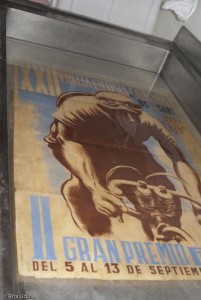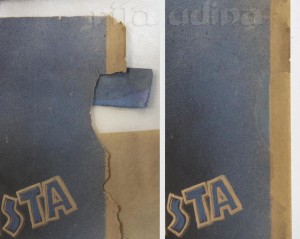Posters conservation: virtual inpaint vs “virtuous” retouching
The bike riders from Sants reached my studio squeaking, rather than cycling!
Tears, foxing, discolouration, brittleness, acidity… All these damages have been carefully treated in order to let the splendorous riders finish line at the Municipal Archive of Barcelona, Sants-Montjuïc District. They are waiting there for you whilst the recently opened exhibition, curated by Daniel Venteo, takes place.
Because, who says that being older than 70 means the end of racing, or renouncing to show off? Just take a look at Ricardo, the cyclist… who would have imagined only weeks before that today he would exhibit magnificent, so fit and good-looking?
And what can we say about his support car and its retinue of cyclists? They are almost centenarian… and yet they ride wild along the repository! Hurry up if you want to see them.
Let me explain briefly which beauty and health treatments these illustrated posters have passed through (clicking the image more information of each process is displayed):
Dry cleaning, wet cleaning, deacidification, mending, sizing, loss infilling and lining, i.e. adding a reinforcing tissue on the back.


Once they were reconstituted and its vigour recovered, we put a slight make up to cheer them up, the exhibition is worth it! It is a subtle retouching, that accompanies and suggests. It enhances the reading and comprehension of the document although keeping a discrete second plan, not being too much protagonist. The goal is not to hide that this sportsmen belong to the ultra-veteran category, the historic section, on the contrary: it’s something to be proud of!


To avoid any invention of whatever might have been in the inpainted area, we resorted to digital technology. A TIFF file taken from a complete issue of the same poster was overlayed to poor crippled Ricardo (previously transferred to bytes). Once the missing part of Ricardo was isolated, a paper sample of this lost area was printed. With this paper sample a calque on the gap of the real poster was made. On the virtuous, not the virtual, poster. Thus the inpainting is done over the restored paper, but covering only the added area, which is made of washi: a japanese paper of long fibres and long term conservation.
And don’t miss the making off: a video by Eva Guillamet that shows the exhibition display, archive research and also images of the restoration process (minute 2:39″)!!!
And also a photographic report by Eva Guillamet and the facebook album with some other images.


